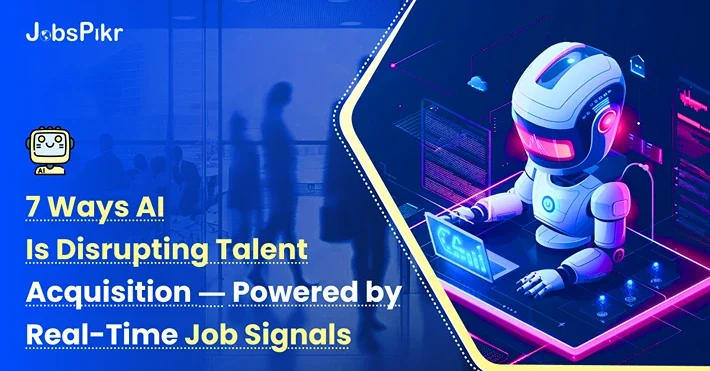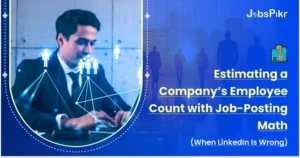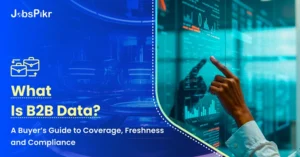- **TL;DR**
- 1. Sourcing That Actually Understands Candidates
- 2. Screening That Doesn’t Miss Hidden Gems
- Stay Ahead of the Hiring Curve
- 3. Making Diversity Data-Driven
- 4. Predicting Tomorrow’s Needs
- 5. Fixing the Scheduling Headache
- Why Real-Time Data Is the Deciding Factor
- The Road Ahead
- Stay Ahead of the Hiring Curve
- FAQs
**TL;DR**
Hiring has shifted from keyword searches and manual resume reviews to AI-driven processes powered by live market intelligence. AI improves sourcing, screening, diversity, prediction, and scheduling — but its real impact comes from combining automation with up-to-date job data. Companies that harness both see faster hiring, higher-quality candidates, and stronger competitive advantages. The future of recruitment is not just about AI — it’s about keeping that AI fueled with real-time insights.
The process of hiring candidates has evolved over the years. In the past, recruiters used to devote their efforts to sifting through stacks of resumes and looking for candidates line by line to ’till they uncovered a buried treasure.’ But in the current world, this won’t even be a second glance. AI has the ability to process resumes within a few minutes and can even assess an organization’s past hiring practices to ‘predict which candidates fit different company cultures.’ Sounds almost like science fiction, doesn’t it?
In some aspects, it is. AI, as it stands, is not a magical silver bullet to solving problems. The companies that are winning the race are not simply “using AI.” They are providing those AI systems with real-time behavioral analytics from the job market to maintain their ‘sharpness’ and relevance to what is really important. Consider it as being in a car and driving with a GPS. If, however, the GPS has not been upgraded past ‘2018,’ you will definitely reach your destination, however, this will be a haphazard process that will cause you to miss road construction, new roads that were built, and even a plethora of new traffic patterns. AI with no result is the same as not having any behavioral patterns from the job market.
Intelligent? Absolutely, however, relevant is a completely different question. Until October 2023, we continued to lose with every passing moment. The type of research that is conducted in this industry anticipates that nearly 66% of businesses consider the adoption of AI to be the most frequently cited development of modern day in the recruitment industry by the year 2025. There is no doubting the fact that the most prominent issue is not the use of AI by companies, but how effectively they manage its utilization.
Let’s analyze five different ways in which AI is currently changing.
Is your team ready to implement AI in hiring?
1. Sourcing That Actually Understands Candidates
For years, sourcing was basically a keyword game. Type “Python developer” into LinkedIn or a database, hit search, and brace yourself for an avalanche of profiles. Some would be a decent match. Many wouldn’t. Recruiters wasted hours fishing through noise, trying to separate the web developers from the data scientists who both happened to list “Python” on their resumes. Modern AI flips the model. Instead of scanning for keywords, it digs into context. It notices how candidates describe their projects. It reads between the lines to understand not just what someone can do, but how they’ve applied those skills.
A machine learning engineer and a backend web developer may both write “Python,” but the way they describe their work tells two very different stories — and AI is good at spotting the difference. The secret sauce is a mix of technologies. Natural Language Processing picks up subtle cues in language. Machine learning continuously studies past hires to see what patterns predict success.
And contextual reasoning helps the system make the kind of leaps a recruiter would: a mobile app developer, for example, might adapt quickly in a fintech role even without direct finance experience. But here’s the catch. If the system isn’t updated with fresh job market data, it’s going to prioritize based on yesterday’s reality. Suppose your AI trained six months ago, when React developers were in sky-high demand.
If the market has shifted toward Vue.js, your tool might still push React-heavy candidates to the top while ignoring the profiles companies are actually hunting for now. With live data feeding the system, everything changes. Suddenly it can see which skills are rising, which ones are cooling off, and which emerging technologies are just starting to break into demand. Recruiters stop wasting time chasing the wrong leads and instead spend more time building relationships with the right candidates. The payoff isn’t theoretical. Companies that pair AI sourcing with live market data have reported 40% better accuracy in matching candidates and 35% faster time-to-hire. Less guesswork, fewer misses, more wins.
2. Screening That Doesn’t Miss Hidden Gems

Resume screening has essentially felt like sifting sand. There is a lunatic where hundreds of applications énormous rush in, and in that lunatic there exists several applications that are a truly great fit. Even to the most diligent recruiter, there is a limited amount of resumes that can be reviewed before fatigue. Overlooked. Other candidates look good on paper but crumble in interviews.
The math transforms with AI-powered Candidate screening systems. Unlike humans, who can only review a handful of resumes in a given time, these systems can process hundreds of resumes and maintain a level of consistency that is often unattainable to people. The most powerful aspect of parsing and screening tools is the customized structure and neomorphic information on the resumes. Having extraction tools, Work History, Requirements, Education, Skills etc can be pulled out no matter what format the document is in.
Counting relevance and weighting, the smooth transition of several scales is executed positively. Having a scrappy start-up, substituting the smooth five years in a slow moving corporation is better in a certain role. Leadership and complex problem -solving is inferred and not only buzzwords in the scope of a project description. The outcome is remarkable. In regard to parsing, there was a 94% and near 90% in skill matching, compared to 70% of the human review. Real-time data is crucial and missing it might compromise accuracy. Such systems might resort to using old data and other techniques to mask the problem.
Stay Ahead of the Hiring Curve
AI and real-time job market data are changing how companies hire. Learn what’s trending and how to prepare your team for the future of recruitment.
3. Making Diversity Data-Driven
Diversity, equity, and inclusion used to be guided mostly by intention. Leaders would say “we need to improve representation,” and teams would set goals or quotas. The problem? That approach sometimes created more noise than clarity. Efforts felt performative, and measuring real progress was difficult. AI has given DEI hiring a more concrete, data-driven foundation. Instead of chasing quotas, companies can let systems evaluate candidates based on skills, experience, and potential while filtering out the factors most likely to introduce bias.
What does that look like in practice? Screening tools can blind identify information so resumes are judged on qualifications alone. Algorithms can flag biased language in job postings — words like “ninja” or “rockstar” that subtly send signals about who “belongs.” Skill-first scoring means candidates are evaluated for what they can actually do rather than whether their backgrounds look traditional. And bias-correction methods can actively adjust for historic patterns where certain groups were overlooked. The impact is measurable. Organizations using AI this way have seen 72% increases in female hires and 58% lifts in hires from underrepresented ethnic groups. That’s not just incremental progress — that’s a step change.
Now add real-time job data into the mix, and you get another layer of power. Market intelligence can reveal which companies are excelling at inclusive hiring. It can highlight real-time salary equity gaps across demographics. It can even show which job descriptions are performing better at attracting diverse applicants. The beauty of this approach is that DEI becomes less about subjective judgment and more about objective, trackable progress. And in a competitive labor market, diverse teams aren’t just a moral win — they’re a business advantage.
4. Predicting Tomorrow’s Needs
ing in the past has often been based on an immediate need. A workforce expands, somebody departs, a new endeavor begins, and voila—recruiters suddenly have to fill these positions immediately. Now, imagine if these needs could be predicted months or years in advance. The answer lies in analytics. The forefront of AI recruiting technology not only identifies positions and roles a company currently has, but also several quarters or even years from now. This can be imagined in three time horizons.
In the short run, it can estimate employee attrition rates or which candidates are most likely to accept an offer. In the mid-range, it can identify potential skills shortages and departments poised for expansion. In the long-term, it can identify new or emergent job roles with changes in the demand of the industry. These predictions rely on several internal and external sets of data. For its internal analyses, AI identifies promotions, performance, project turnover, and market share. Externally, it observes industry-wide hiring rates, salary changes, and job listings of competing companies.
Predictive models are estimated to have an 80% accuracy rate in predicting skills gaps for the next three years. Without a doubt, the difference between good and great is the time gap. Let’s say, for instance, you’re planning to expand a machine learning team. Your best guess, based on historical growth, is that you’re safe. However, live market data could indicate otherwise.
Is your team ready to implement AI in hiring?
5. Fixing the Scheduling Headache
Scheduling interviews may not be the most thrilling ventures, but it is one of the most annoying aspects of recruitment. Scheduling interviews takes recruiters almost half their time. The first interviews alone, get postponed for more than a week. Therefore, when time is lost, your top candidates get other offers This is yet another problem that AI has been able to solve.
AI Exam, for instance, allows for intelligent scheduling whereby calendars sync automatics across systems, time zones are converted, and candidates choose from standard time zones. Instead of dozens of emails, it takes a simple click. What’s the outcome? Under 24 hours response time has replaced the previously existing 7 days, leading to candidates’ satisfaction scores improving drastically. While it may appear trivial, it can change the game completely in a competitive market. And here’s where real-time data adds another edge.

If the market shows senior developers in your region are typically snapped up within five days, the system can flag those candidates for expedited scheduling. It can even recommend changing the interview panel if certain combinations historically lead to faster, more successful hires. Companies using AI for scheduling and process optimization report 35% faster hiring cycles and significantly better candidate experiences. And in today’s job market, experience matters almost as much as compensation.
Why Real-Time Data Is the Deciding Factor
There’s a clear pattern in every one of these examples. AI is powerful — but without live inputs, it’s prone to drift. Skills rise and fall. Salaries shift. Competitors pivot their strategies. A model trained six months ago might still be automating, but it’s not necessarily helping. That’s why real-time job market intelligence has become the deciding factor. It turns automation into strategy. It makes predictions actionable. And it ensures that hiring decisions reflect today’s reality, not last year’s trends. Organizations that combine AI with live data report 30% stronger outcomes, 25% faster time-to-hire, and 35% better candidate quality. That’s not just operational efficiency — that’s a competitive moat.
The Road Ahead
And here’s the exciting part: we’re only just beginning. By 2030, experts predict AI will be capable of running first-round interviews that feel almost indistinguishable from human conversations. Predictive models will surface passive candidates before they even start looking. Job descriptions will rewrite themselves in real time based on market conditions. And talent acquisition will flow seamlessly into workforce planning, creating pipelines that are proactive, not reactive. In other words, hiring won’t just be faster.
It’ll be smarter, fairer, and more strategic. But only for the companies that understand the formula: AI is the engine. Real-time market data is the fuel. One without the other doesn’t get you very far. Together, they’re rewriting the rules of talent acquisition. AI has already reshaped hiring. That’s not up for debate. But the organizations that are pulling ahead aren’t just experimenting with automation; they’re feeding their systems with the freshest, most relevant job market intelligence.
The winners in the talent war will be those who:
- Source with context, not just keywords.
- Screen without overlooking hidden gems.
- Build diversity on a foundation of measurable fairness.
- Predict tomorrow’s needs before they become emergencies.
- Fix the operational bottlenecks that frustrate candidates and recruiters alike.
The future of hiring isn’t on the horizon — it’s here. Faster, smarter, more data-driven than ever. The only real question left is: are you ready to embrace it?
Stay Ahead of the Hiring Curve
AI and real-time job market data are changing how companies hire. Learn what’s trending and how to prepare your team for the future of recruitment.
FAQs
1. What does an AI recruiter do?
An AI recruiter saves and streamlines the time spent on mundane, repetitive tasks like sourcing and screening resumes, predicting candidate fit, scheduling interviews, and even candidate screening. It uses AI to facilitate these tasks.
2. In what ways can AI assist in acquisition of talents?
AI can identify and retrieve the best candidates faster. It can also scan and evaluate many resumes, identify hidden talents, eliminate bias in screening, and predict possible future hiring needs. Thus, AI increases recruitment efficiency.
3. In the context of recruitment, what are the advantages and disadvantages of AI?
AI increases the speed of recruitment processes, increases the precision and accuracy of the tasks that are performed and lowers the bias in the recruitment process. Therefore, AI is good for recruitment. It is important to note that AI systems do not work in real time and are unmonitored, they can make a lot of mistakes.
4. Will AI take the place of Human Resources?
Complete takeover of HR functions by AI is not possible. Screening and scheduling can be automated, but the AI still needs to be paired with humans that will make the major decisions, build the connections, and maintain the cultural alignment.
5. What are the risks of AI in hiring?
Potential risks include the use of obsolete information, certain types of bias in the algorithms, and over automation by AI that ignores the human touch and the human attributes. These can be mitigated if AI is used alongside real-time data and human insight.




